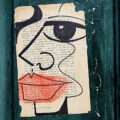White Heart-Flame of Polished Silver: Amy Lowell and Mary Meriam

Amy Lowell was born in Brookline, Massachusetts, in 1874, youngest daughter of the wealthy Boston Lowell family that would later include acclaimed poet Robert Lowell among its members. From the eighteenth through the middle of the twentieth century, the Lowells were one of the most prominent “Boston Brahmin” families, producing numerous influential writers, judges, scientists, innovators, and social activists. Amy’s father, Augustus Lowell, was a classic nineteenth-century industrialist, while her brothers, Percival and Abbot Lawrence, became a celebrated astronomer and a President of Harvard University, respectively. From a young age, Amy Lowell imagined following in the footsteps of her elder cousin, the poet, Atlantic Monthly editor, and ambassador James Russell Lowell.
Ignoring the family’s encouragement to become a socialite and focus on marriage, Lowell read voraciously, and at the age of thirty-eight she published her first volume of poems, entitled A Dome of Many-Coloured Glass (1912), to little critical attention. Shortly after, however, Lowell discovered the Imagist movement. Her style rapidly developed under its influence.
For a relatively brief moment in the early twentieth century, Amy Lowell’s name reverberated through discussions of the New Poetry in America. Her work was associated with the daringly modern and cutting-edge, as she experimented with form—championing vers libre and inventing her own form of “polyphonic prose” (unrhymed prose poems)—published prolifically (producing eight volumes of poetry within ten years), and performed her work to packed halls across the USA and in Europe. She also used her considerable wealth and influence to promote the work of other experimental poets she admired, such as H.D., Richard Aldington, F. S. Flint, and D. H. Lawrence. At the apex of her career, Lowell was awarded the Pulitzer Prize for Poetry, posthumously, for her collection What’s O’Clock.
For the bulk of the twentieth-century, however, Lowell and her poetry were forgotten, even disparaged. This may have been due, in part, to the personal and artistic attacks that followed her death in 1925, such as Clement Wood’s malicious 1926 biography that vilifies her on the basis of her gender, her body, and her sexuality. The forgetting of Amy Lowell was furthered by the misogynist and homophobic atmosphere that pervaded (and in some quarters, still pervades) the study of literary modernism during the middle of the twentieth-century. Because of all this, the two main things people tend to know about Amy Lowell are that she was very fat, and that she annoyed Ezra Pound by “stealing” the Imagist movement from him—a myth of course perpetuated by Pound himself.[i] Lowell was reduced to a footnote in stories of Pound and the Imagist movement, surviving only as a punch-line or a “walking sideshow” as she described herself in a moment of self-doubt.
The last decades of the twentieth-century catalysed a significant shift in the view of Lowell and her work. In the 1980s, Lowell re-entered critical discussion as a masterful lyricist whose poems expressed lesbian desire with unprecedented boldness. Lilian Faderman’s ground-breaking study of lesbian literature, Surpassing the Love of Men (1981), paid close attention to Lowell’s poems—particularly in the “Two Speak Together” sequence of her third volume Pictures of the Floating World (1919). Critic Paul Lauter would refer to “Two Speak Together” as “the most fully articulated sequence of lesbian poetry between Sappho and the 1960s,” whilst Faderman describes it as “of the most detailed records in literature of an emotional and erotic relationship between two women.”
Lowell’s best-known works are the love poems she wrote for her partner, the actress Ada Dwyer Russell, with whom she shared her magnificent Brookline home, Sevenels. Ada was a character actress from Salt Lake City, Utah, who had previously been married and had one daughter. Lowell met Ada in 1909 following her Boston performance of Frances Hodgson Burnett’s The Dawn of a Tomorrow. They met again at a ladies’ lunch club in 1912, when Russell was appearing in Paul Armstrong’s The Deep Purple (1911). Lowell pursued Russell for some time “with the proposition that she give up acting and come to live with her at Sevenels.” It wasn’t until 1914, following a trip to England they took together, that Russell agreed to be Lowell’s permanent companion. Though unusual, such domestic arrangements were not unheard of in New England. Similar situations might be found at women’s colleges, in which female faculty often lived together, and Henry James’s sister Alice lived in such a union with Katherine Loring—inspiring James to write The Bostonians (1886), in which James even uses the term “Boston marriage” to describe such co-habitation between women.
In giving up the stage, Russell became the dutiful domestic “wife,” materially and psychologically enabling Lowell to occupy the role of poet. Faderman describes her as “charming, cultural, poised, intelligent, and feminine—in short, everything Lowell sought in a muse.” She points out the autobiographical details found in Lowell’s poems (features of the house itself, the gardens, and Lowell’s beloved dogs) and the sensuous images Lowell repeatedly uses to represent Ada—including erotic floral imagery, gems and jewels, jets of water, flames and, most importantly of all, the moon—so closely associated with Ada that in one poem the speaker asks “which is the reflection?” Lowell’s poems, Faderman argues, build a picture of love between two women that is barely censored; instead it is celebrated, rapturously, using quasi-religious symbolism to encode erotic ecstasy.
And this is where the poet Mary Meriam—with bravado worthy of Lowell herself—enters the conversation. Meriam’s volume Lady of the Moon, is composed of three distinct parts. The first is a selection of twenty-nine of Lowell’s own poems, mostly drawn from Pictures of the Floating World. The middle section is a reprinted version of Faderman’s classic revisionary essay, exploring the key images that Lowell uses to represent her beloved Ada.
The final section consists of a sequence twenty-seven new poems by Meriam herself, inspired by Lowell’s work and the details of her life with Ada, skillfully interlaced with the metaphors and symbolism that Lowell used to portray her muse. Meriam’s poems seek to “fill in the gaps” in their love story, by imagining Amy speaking directly to Ada, and the intimate details of their life together—following them down twilit garden paths, up the stairs of Sevenels, and behind the bedroom door, so to speak. The sequence is, in this sense, literally a labour of love, as Meriam’s poems revive Lowell’s most memorable and distinctive images of devotion and eroticism. The ambition of these poems is laid bare in one particularly revealing couplet from Sonnet 23:
Someday a sister will be reading this;
I only want to help her reminisce.
Meriam is—like Lowell in her poem “The Sisters”—reaching out to her own “queer lot”; these poems speak to an imagined (and of course, very real) community of women, past and present, who hunger to celebrate love between women in words that are delicious, ripe and piquant on the tongue.
Meriam is wise to include Lowell’s own poems at the start of her volume, since her own versions are heavily influenced by these; the opportunity for direct comparison makes her achievement clear. The Lowell poems reprinted here trace the development of her courtship with Russell, from the frustration of premature separation expressed in “The Taxi”—
When I go away from you
the world beats dead
Like a slackened drum.
—through the anxiety and uncertainty of “Left Behind”—“Without you, there is no garden”—to the triumphant commitment of “A Decade”:
When you came, you were like red wine and honey,
the taste of you burnt my mouth with its sweetness.
Now you are like morning bread,
Smooth and pleasant.
I hardly taste you at all for I know your savour,
But I am completely nourished.
The euphoric “Madonna of the Evening Flowers” is representative of Lowell’s portrayal of Ada across these poems, so is worth reproducing in full:
All day long I have been working
Now I am tired.
I call: “Where are you?”
But there is only the oak tree rustling in the wind.
The house is very quiet,
The sun shines in on your books,
On your scissors and thimble just put down,
But you are not there.
Suddenly I am lonely:
Where are you?
I go about searching.
Then I see you,
Standing under a spire of pale blue larkspur,
With a basket of roses on your arm.
You are cool, like silver,
And you smile.
I think the Canterbury bells are playing little tunes,You tell me that the peonies need spraying,
That the columbines have overrun all bounds,
That the pyrus japonica should be cut back and rounded.
You tell me these things.
But I look at you, heart of silver,
White heart-flame of polished silver,
Burning beneath the blue steeples of the larkspur,
And I long to kneel instantly at your feet,
While all about us peal the loud, sweet Te Deums of the Canterbury bells.
If the reader remains in any doubt that the somewhat impatient speaker here can be aligned with Lowell herself, and the gloriously serene “Madonna” (handy with scissors, thimble, and perhaps even garden shears, by the sounds of things) is Ada, then consider the fact that when Lowell’s friend John Livingstone Lowes asked whether his wife’s “immediate identification of the Madonna” with Ada was correct, Lowell replied playfully, “How could so exact a portrait remain unrecognised?”
However, as Melissa Bradshaw has observed elsewhere, Lowell must be aware that “an ‘exact portrait’ is precisely what she does not give,” for “We do not see the beloved. We never see her. Though she is infinitely invoked … Lowell’s beloved remains unnamed, unknown, in a sense, unwritten … an amorphous, delectably intangible beloved.” Lowell is a master of simultaneously concealing and revealing the object of her adoration. Throughout these poems, we catch tantalizing glimpses of the muse, but she evades our grasp. In “A Sprig of Rosemary,” Lowell writes:
I cannot see your face.
When I think of you,
It is your hands with I see.
Your hands
Sewing,
Holding a book
In another poem, the nude beloved flickers away from the speaker’s burning touch:
You stand between the cedars and the green spruces,
Brilliantly naked
And I think:
What are you,
A gem under sunlight?
A poised spear?
A jade cup? […] My hands are flames seeking you,
But you are as remote from me as a bright pointed plant
Set in the distance of an evening sky.
This “white heart-flame of polished silver” flashes through the poems, but remains elusive, mercurial—but the desire invoked is none the less visceral and erotic for that. Many of Lowell’s poems are strikingly sexual. In the suggestively titled “The Weather-Cock Points South,” for instance, the speaker describes the beloved as a white flower which she delicately caresses:
I put your leaves aside,
One by one:
The stiff, broad outer leaves;
The smaller ones,
Pleasant to touch, veined with purple;
The glazed inner leaves.
One by one
I parted you from your leaves,
Until you stood up like a white flower
Swaying slightly in the evening wind.
Here Lowell subverts the centuries-old association of flowers with femininity and romance in order to praise her female lover in audacious homoerotic terms. The fact that Lowell published such poetry nine years before Radclyffe Hall’s The Well of Loneliness was put on trial for obscenity proves that her sensual code was as subtle as it was bold.
Meriam’s twenty-seven poems (most of them sonnets) follow the development of Amy and Ada’s courtship from their first meeting to their domestic bliss at Sevenels. The first three poems in the sequence explore Lowell’s anxiety as she pursues Ada, following her like a love-sick puppy as Ada toured America. Sonnet One brilliantly captures Lowell’s assertive yet often doubtful tone as she falls for Ada under the footlights:
I know my mind, and I’ve read many books.
Romance, I thought, would always pass me by,
Lovely romance, her fervent, fluttery looks
Not meant for me. I turned away, too shy.
Then I set eyes on Ada. Through the gloom,
The curtain rising, the thunderous applause—
Or was the thunder mine alone?—the room,
So dark before, struck lightening, and the cause
Was Ada’s voice and hair and hands and dress
Playing on all my senses like the world
Seen fresh in childhood. I kept my seat, but less
Sure of my place, myself, my past uncurled
And left me present with desire
To hold this woman’s flames of silver fire.
Observe how Meriam’s poem incorporates Lowell’s most important images—voice, hair, hands and dress and her association with “silver fire.” Even more cleverly, Meriam’s poem echoes Lowell’s first ever poem, which was written in 1902 and inspired by the Italian tragedian Eleanora Duse. Lowell’s poem, eventually published in 1923, dwells on the moment of anticipation before the curtain lifts. Lowell herself aspired to a career as an actress; her public readings were said to be spectacularly dramatic. Meriam skillfully utilizes this theatrical metaphor to set the scene for Amy and Ada’s great romance. The notion of “role-playing” continues in Poem 3—“The play will end, / And then, what gesture will the world permit?”—and in Poem 4, in which Amy reminds herself to “Slow down and let your Ada learn the role.” This performs the contradiction that pervades Lowell’s own lyrics: the desire to express one’s great love—to shout it from the rooftops, as Lowell imagines herself doing in some poems!—and the necessity to conceal it by playing a very different role in public; that of dearly devoted friend or dutiful companion.
Here again, Meriam captures Lowell’s voice in a poem suffused with the sensual imagery that Lowell used to describe her beloved:
O moon so close to full this summer night,
Under your gaze we glide across the grass,
The sleeping flower beds and fountain white
Caressed. Aroused by light, the lily glass
Jiggles and spills her fragrance for the two
Of us. We pause along the path, her face
So close that there is nothing I can do
But kiss her eyes and lips and then retrace
My kiss from lips to eyes.
However, while Ada appears in these poems as muse and object of passion, her voice remains largely absent. Only one of Meriam’s poems is written in Ada’s voice—Poem 19, which is printed facing Poem 18. In Poem 18, Amy addresses Ada and concludes with “Two speak together on a Saturday.” Poem 19 begins with Ada’s reply:
Amy, I throw myself across to you,
Wavering thread without a needle’s eye,
Here in the dark embroidered bed of night.
You wrap your voice around, the knot is tight.
The knot is tight indeed. Lowell joked that Sevenels should bear the sign “Lowell and Russell, Makers of Fine Poems,” but the extent of Ada’s collaboration remains a mystery.[ii] Ada is undeniably the silent partner in the relationship—and yet it was due to her support that Lowell was able to be so prolific. It was Ada who edited and produced three posthumous volumes after Lowell’s death. It was Ada who read Lowell’s work in public, sustaining her legacy. And yet her contribution has been overlooked, as critics prefer to portray her as a beautiful muse rather than a hard-working, professional woman in her own right. Lowell is of course complicit in this—she urged Ada to leave the stage. It is difficult to get away from the sense that, in a troubling manner, Lowell’s poems speak for Ada, rather than speaking with her.[iii]
While the issue of Ada’s voice in Meriam’s poems reflects Lowell’s own choices, the issue of poetic form is another matter. The majority of the poems in Meriam’s sequence are Shakespearean sonnets, an odd decision for an homage to a poet who rejected fixed forms. Lowell preferred free verse, experimenting with “unrhymed cadence” in her prose poems (most notably in Can Grande’s Castle, 1918). From one perspective, this enables Meriam to avoid outright imitation, which risks parody. It also makes for an interesting juxtaposition, as Lowell’s images are twined around the intricate trellis that is the sonnet structure. One the other hand, the sonnet form feels restrictive after reading Lowell’s own work, and results in slightly clunky couplets such as “you cannot become my muse and wife, / You have a job to do, you have your life.”
Still, the romantic sonnet sequence constitutes a long and successful tradition for women poets, from Elizabeth Barrett Browning’s Sonnets from the Portuguese to Adrienne Rich’s Twenty-One Love Songs. For Lowell to enter such a tradition through Meriam does have a certain poetic logic, even if it drags the radical experimenter into formal fixity. And not all Meriam’s poems are sonnets. Poem 13 has an imagist brevity and erotic urgency worthy of Lowell herself; indeed, a number of the poems at the centre of the sequence break the formal regularity as orgasmic ecstasy takes over:
In this one I am kissing you your lips my bliss
your breasts at last your lips your mouth high blisshow do I know it’s you my fantasy my muse
hidden inside my mind where I alone cry bliss
Meriam’s sequence concludes with Lowell anticipating her early death (she died of a cerebral haemorrhage at the age of fifty-one), echoing Lowell’s poem “Penumbra,” which pictures Ada alone at Sevenels (“The old house will guard you, / As I have done”). Meriam’s poem imagines Lowell leaving a message to Ada:
I write these lines for you
To keep you company when you are blue.Ah, Dear, I love you!
This final line (Ah, Dear, I love you!) is lifted from Lowell’s poem “Frimaire,” which depicts the two women as purple and red flowers, the sole survivors of the winter frost. In that poem, Lowell asks that she be taken first:
Surely frost should take the crimson.
Purple is a finer color,
Very splendid in isolation.
And indeed, her prediction proved to be true. It is fitting that Lowell should speak in her own words at the end of this new sequence. Meriam’s powerful love poems stand as fine examples of erotic poetry in their own right, and ought to reawaken people to Lowell’s works, which remain as fresh, bold, and sensual as they were when originally published.
[i] Those interested in reading about Lowell’s body should consult Melissa Bradshaw, ‘Remembering Amy Lowell: Embodiment, Obesity, and the Construction of a Persona’, in Amy Lowell, American Modern, eds. Adrienne Munich and Melissa Bradshaw (New Brunswick, New Jersey and London: Rutgers University Press, 2004, pp.167-185) and to my own chapter ‘Amy Lowell’s Appetites’, in Fat Sex: New Directions in Theory and Activism, eds. Helen Hester and Caroline Waters (Farnham, Surrey: Ashgate, 2015, pp.159-180).
[ii] My argument regarding the important role of Ada Russell is outlined in my book The Lesbian Muse and Poetic Identity (Routledge, 2013).
[iii] Those interested in this idea should consult Sandra M. Gilbert and Susan Gubar, No Man’s Land: The Place of the Woman Writer in the Twentieth Century. Volume Two: Sex Changes (New Haven: Yale University Press, 1989).
About Sarah Parker
Sarah Parker is a Lecturer in English at Loughborough University. Her first monograph is The Lesbian Muse and Poetic Identity, 1889-1930 (Routledge, 2013). Her other publications include articles on Michael Field, Olive Custance, and chapters on Amy Lowell (Fat Sex, Ashgate, 2016) and Amy Levy and Djuna Barnes (in Economies of Desire at the Victorian Fin de Siècle, Routledge, 2016). She is currently working on a monograph project entitled “Picturing the Poetess: Women Poets and Photography, 1880-1930”. An article entitled “Publicity, Celebrity, Fashion: Photographing Edna St. Vincent Millay” is forthcoming from Women's Studies.





